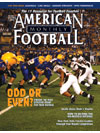AMERICAN FOOTBALL MONTHLY THE #1 RESOURCE FOR FOOTBALL COACHES
Article CategoriesAFM Magazine
|
What Do You Mean You Guys Don\'t Bench? Not At All?Do things right; Do the right things; the key to optimizing weight training performance© More from this issue "Whenever you find yourself on the side of the majority, it is time to pause and reflect"—Mark Twain I can’t begin to tell you how many times I’ve had to answer the title of this article in the past four years—from all factions: fans, players, parents and even other coaches. As you well know, in our profession anytime we go against the norm there is some inherent risk. There is safety in conformity. “If the league champ is running the spread, then we will too. So and so runs the 3-5, we do too.” That way, criticism is deflected to other areas. I have to admit that I’m guilty of it too. After our 1-9 first season where we ran the unconventional single wing, we quickly moved to the popular spread offense ourselves. Sometimes when faced with a problem; however, you have to take a risk.<....The full article can only be seen by subscribers. Subscribe today!
|
|
|||||||
| HOME |
MAGAZINE |
SUBSCRIBE | ONLINE COLUMNISTS | COACHING VIDEOS |
Copyright 2025, AmericanFootballMonthly.com
All Rights Reserved





